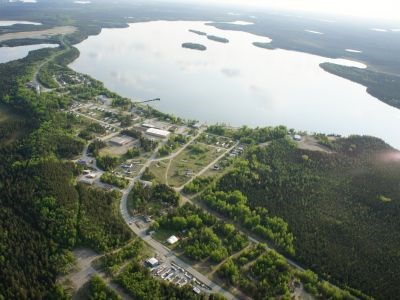Pickle Lake Mayor Karl Hopf said his northwestern community is being “handcuffed” by a one-size-fits-all provincial policy that’s stonewalling future development.
Drafting a new Official Plan for the township of 425 has stirred the pot on a four-decades-old environmental legacy issue that’s resulted in a standoff between the municipality and three provincial ministries.
Red flags have been raised from the presence of arsenic in old surface tailings from a mine that closed in the 1950s. It’s caused the province to curb any new development along a highway corridor that the municipality wants to set aside for business opportunities.
The township is now at loggerheads with the Ministry of Municipal Affairs and Housing in refusing to sign off on a new Official Plan until the province finally commits to remediating the site.
“For 40 years, they keep saying it’s a health issue,” said Hopf. “Well, let’s fix it.”
The discovery of gold in the 1920s near the shores of Pickle Lake brought people north, leading to the eventual establishment of the township, which sits at the end of Highway 599.
The Pickle Crow Mine closed in 1966. Closer to town, the Central Patricia Mine mined its last ounce in 1954.
Until the early 1990s, when provincial mine closure plans with financial assurances were invoked, miners could walk away from these hazardous sites after their operations closed.
At the Central Patricia site, Hopf said the volume of tailings, spread over multiple sites, has never been accurately measured despite four provincial studies being done, the last in 1989.
To what extent it represents an environmental or health hazard, or the levels of contamination to the local watershed, has never been fully assessed either.
In the late 1970s, the province offered a paltry $4,000 stipend for residents living near the former mine to leave. Ten homeowners still remain.
And there are further concerns about potential subsidence issues from old underground workings.
Hopf said the last study indicated it would take 250,000 cubic metres of fill to cover a tailings area of roughly two square kilometres, a multi-million-dollar job that the township can’t be expected to pay for.
Most frustrating is a new provincial restriction not allowing any new development within 1,000 metres of the former mine’s still-standing headframe.
Under Ontario’s Planning Act, until issues from a man-made hazard — like a mine — are addressed or rehabilitated, development activity isn’t permitted.
Conceivably, Hopf said, 700 acres could be removed from use. And special government-imposed conditions on properties bordering that exclusion zone could affect 2,000 acres.
The old headframe sits 50 metres off the main highway through town that goes north to service 21 communities and the Musselwhite Mine.
A gas station and some trucking companies still operate in the area, but it’s off-limits to new construction.
Hopf said Pickle Lake can’t be sustainable under these conditions, mentioning he’s grown tired of empty promises and the lack of solutions from the Ministries of Environment, Municipal Affairs, and Northern Development and Mines.
“Instead of being mentors and helping us, they handcuff us in Northern municipalities.”
When the province and industry finally acts on carving out a west-to-east road to the Ring of Fire mineral deposits, Pickle Lake wants to reap some of the rewards with new development.
Some negotiating power may come in form of proposals by two First Nations-owned power companies to extend grid power to remote communities.
Should the transmission lines come through town, Hopf said the local hydro substation — which sits within that exclusion zone, some 350 metres from the headframe — would have to be rebuilt.
“Pickle Lake is not going to become the metropolis of the North just because the (Ring of Fire) road and transmission line goes through,” said Hopf, “but we can’t have our hands tied and have people just whizzing by our municipality.”
If developable land is taken out of circulation, Hopf said the municipality will refuse to sign the draft for a new Official Plan and will continue operating under the old one.
Recently, Hopf believes he has a concession from the province to identify the tailings sites and measuring the volume using GPS.
He’s also received assurances from Northern Development and Mines Minister Michael Gravelle that “it was not their intent to put roadblocks in the way of development in Northern communities.”
Staff from the Abandoned Mines Rehabilitation Program is being consulted, but with 4,000 abandoned sites across Ontario to be addressed, priorities must be ranked for what potentially be a $30-million to $40-million remediation job, he said.
“We came to the conclusion together that nothing is going to happen for a good two years,” said Hopf.




